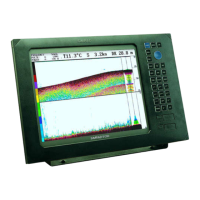EQ42/50/52 Principles of operation Chapter 8
41
8.1 Parts of an echosounder
An echosounder is composed of a display screen, processor, and receiver/
transmitter unit which in the case of the EQXX, are housed in one unit.
Connected to this unit by a shielded cable is the transducer which is mounted
horizontally on the bottom of the hull or on the transom.
8.1.1 Display screen
The display screen presents in graphic and numerical form the information the
processor is receiving and accumulating from the transducer.
8.1.2 Processor
The processor is the “brain” of the echosounder. It is sealed inside the unit which
protects it from harm. The processor is composed of highly sophisticated micro-
processor, memory and logic circuitry.
8.1.3 Receiver/transmitter
The receiver/transmitter (often called the “transceiver”) section of your echo-
sounder takes it’s commands from the processor. The processor tells the trans-
ceiver to activate the transmitter. The transmitter sends a high voltage transmit
“ping” to the transducer mounted on the hull. At that point the transmitter’s job is
done and the receiver takes over. See Figure 1.
The receiver is also connected to the transducer and amplifies the very small
signals received as echoes from fish and the sea floor which arrive at the trans-
ducer (see Figure 2). The receiver is designed to reject other signals as much as
possible and to provide enough amplification to see even relatively small targets
at long ranges.
The amplified receiver signals are then send to the processor to be shown on the
display screen.
8.1.4 Transducer
A transducer can be single or multiple ceramic elements in a rugged housing
made from reinforced plastic, bronze or stainless steel.
The transducer is attached horizontally to the bottom of the hull. It is essential
that the transducer be mounted properly (see chapter 9. Installation and service),

